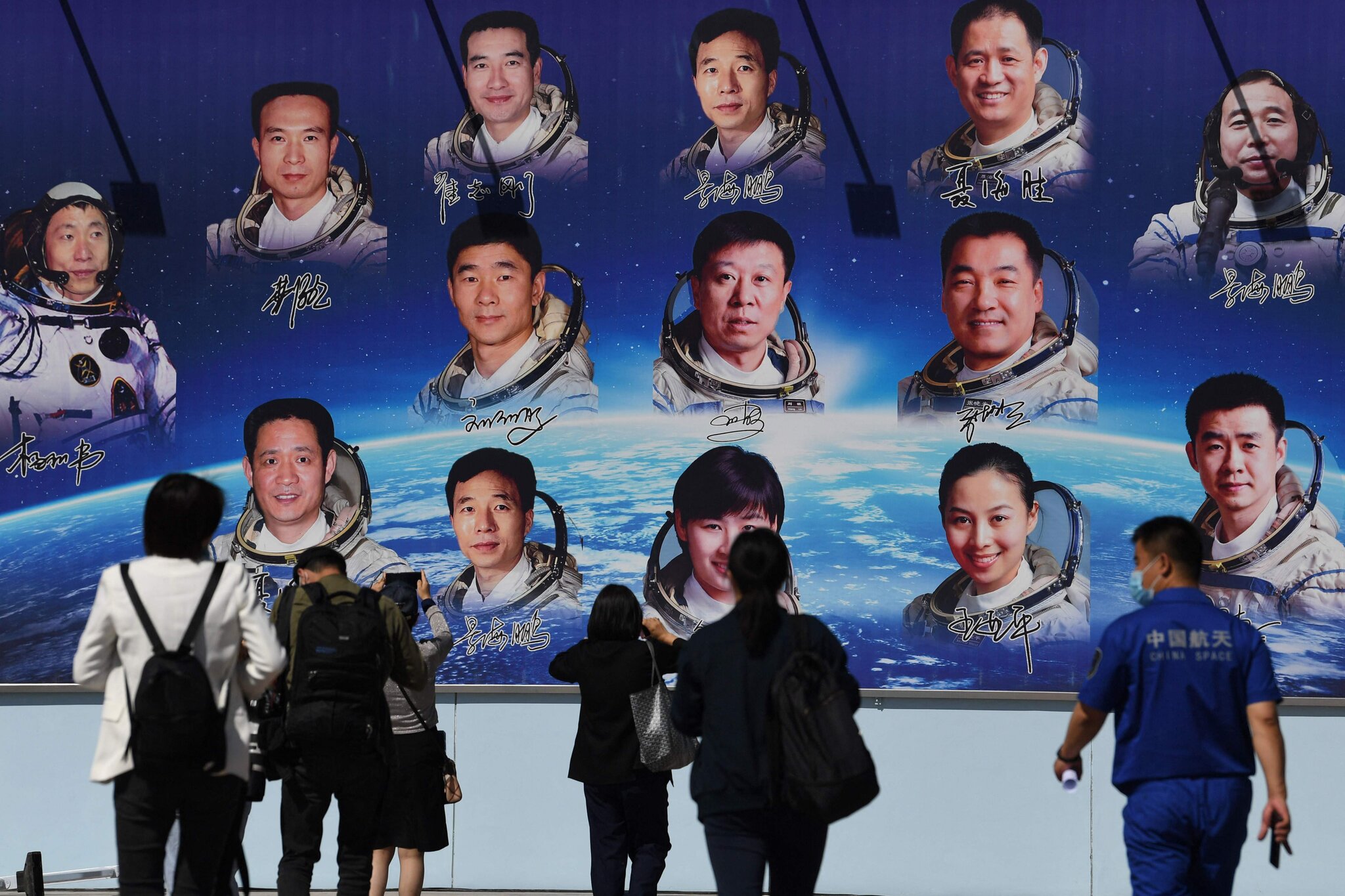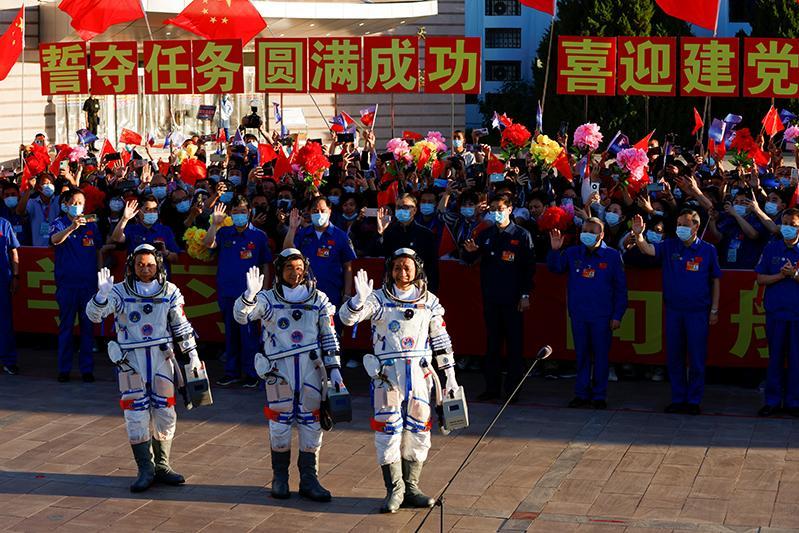China Launches Astronauts to Space Station
Three Chinese astronauts, the first since 2016, launched into space. They will begin what is expected to be a continuous Chinese presence in Earth’s orbit for the next decade.June 16 2021
A Chinese space official called the launch to orbit “a complete success” about 20 minutes after the liftoff.
There will soon be two places in orbit where astronauts live.
On a clear, sunny Thursday morning in the Gobi Desert, three Chinese astronauts lifted off. They waved to cameras in their capsule as their trip to space began. Twenty-one minutes into the mission, the director of the launch center, Zhang Zhifen, announced that it was “a complete success.”
If all now goes according to plan, they will rendezvous with China’s nascent space station later in the day. Two of the outpost’s modules were launched in April and May.
The Chinese space station, called Tiangong, or Heavenly Palace, joins the International Space Station, the project led by the United States and Russia that has been continuously occupied for more than two decades.
Thursday’s launch is the third of 11 missions planned to complete construction of China’s first long-term outpost in space before the end of next year.
In China, the construction of the space station has been treated with unusually public fanfare, a reflection of growing confidence by the country’s leadership in its space missions, which have achieved a number of major successes in recent months.
The launch of China’s space station comes at a time when Russia and the United States are squabbling over the future of the International Space Station, and as China and Russia are growing closer in space cooperation.
The astronauts soared into space aboard Shenzhou-12, a spacecraft that will dock to the two modules launched earlier. It will effectively become another piece of the space station, which is orbiting 242 miles, or 390 kilometers, above Earth. (The International Space Station is slightly higher at 248 miles.)
A related spacecraft, Shenzhou-5, carried the first Chinese astronaut to space in 2003, making China the only country besides the United States and the Soviet Union and, its successor, Russia, to complete the feat independently. China has since carried out five more crewed flights into orbit, the last in 2016.
How long will the trip to orbit last?
The China Academy of Space Technology told The Global Times, a state newspaper, that the trip to the orbital module would take about 6.5 hours. When it arrives on Thursday evening, the spacecraft will autonomously dock with the station.That’s similar to the time of a flight in May of a cargo vessel called Tianzhou, which docked with the core module about eight hours after it launched. It carried several tons of supplies to equip and sustain the station, which will have three bedrooms, a bathroom, and places for the astronauts to eat and exercise.

A display of photos of Chinese astronauts at the Jiuquan Satellite Launch Center.Credit...Greg Baker/Agence France-Presse — Getty Images
How long will they stay and what will they do aboard the station?
The crew of Shenzhou-12 is scheduled to spend the next three months in orbit. After that a second crew of three astronauts will replace them.The station remains under construction, so the astronauts’ main tasks will effectively be to continue to build it, installing equipment like cameras and testing various functions, including life support and waste management. They are scheduled to conduct two spacewalks as part of that effort.
Mr. Nie, the commander, told reporters in Jiuquan on Wednesday that this mission would be more arduous and challenging than his previous two.
“We will not only have to arrange the core module, the ‘space home,’” he said, “but also to carry out a series of key technology verifications.”
What is China’s space station and what will it do?
China’s first two space stations were short-lived prototypes, but the Tiangong is intended to operate for at least a decade, joining the International Space Station.The Chinese station will serve as an orbiting laboratory for the country’s space program, allowing it to perfect operations and conduct new experiments — at least nine of them, so far, with international partners. Officials have said that once the station is completed next year, they will consider ferrying foreign astronauts to the station.
Mr. Ji, the assistant director, acknowledged at a briefing that China was “a latecomer” when it came to developing an orbiting space station, a feat the United States and Soviet Union accomplished decades ago. He noted, however, that China benefited from “latecomer advantages,” presumably the experiences of those previous stations.
Like all of China’s space missions, its successes in space are seen as a validation of the Communist Party’s rule. Mr. Ji noted that the Shenzhou’s crew would be in orbit on July 1, the official anniversary of the founding of the Chinese Communist Party in Shanghai 100 years ago.
“The construction and operation of the space station can be considered an important symbol,” he said, “measuring a country’s economic, technological and comprehensive strength.”
What else is China’s space program doing?

A photo of China’s Zhurong rover captured via a remote camera on Mars.Credit...China National Space Administration
China’s space program has had a very successful series of launches and landings in recent years.
Most recently in May, it set down Zhurong, a robotic rover, on the surface of Mars. That made it only the second country, after the United States, to accomplish such a technical feat, as many Mars landing attempts have ended in crashes.
Another robotic Chinese mission landed on the moon in December, collected lunar rocks from the surface and returned them to Earth weeks later. That made China only the third nation, after the United States and the Soviet Union, to complete such a round-trip.
These successful endeavors have added to the likelihood that China will keep to its proposed timelines for other deep space missions. In addition to a series of robotic journeys to the lunar surface, the country will aim to collect samples from a near-Earth asteroid and return them to Earth around 2025 — something Japan has done twice. It also intends to launch a mission around 2030 to collect samples from Mars and bring them back to Earth, something NASA and the European Space Agency are collaborating on in the coming years as well.

China Launches 3 Astronauts Toward New Space Station (Published 2021)
The crew, the first to launch since 2016, will begin what is expected to be a continuous Chinese presence in Earth’s orbit for the next decade.


